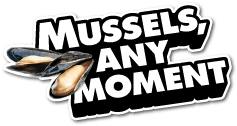Wadden Sea and Eastern Scheldt cultivation areas
In bottom cultivation, the raising of mussel seed into mussels for consumption takes place in the Eastern Scheldt and in the Wadden Sea. Mussels are also cultivated in the German section of the Wadden Sea; these are sold through the Dutch Mussel Auction in Yerseke. In total, roughly 7,000 hectares of cultivation beds are involved, most of which are in the Wadden Sea. Due to the strong influence of ebb and flood – and the ensuing higher supply of food for mussels – this is the most suitable area for cultivation. Dynamic environmental characteristics however mean the yield here is not as constant as in the Eastern Scheldt. Storms and the presence of predators such as (eider) ducks, crabs and starfish can substantially impact mussel quantities in the Wadden Sea. Due to its sheltered location, the risk of loss due to storms is minimal in the Eastern Scheldt.
Cultivation areas elsewhere
The partial cultivation of Zeeuwse mosselen – mussels from Zeeland – outside of Zeeland dates back to 1950. In that year, the Eastern Scheldt was afflicted by a parasite which affected the entire mussel population. As a result, the first mussel growers from Zeeland started shifting to the Wadden Sea. Mussel fishery had already been occurring in the Wadden Sea (mussel seed and half-grown mussels) but cultivation was not yet taking place here. Over the following decades, the cultivation of mussels developed favourably. In the meantime, the mussel sector managed to conquer the parasite. For both Dutch cultivation areas combined, this resulted in an annual production of around 100 million kilograms in the 1990s. About 80 percent of this came from the Wadden Sea. To this day, the Wadden Sea is still the leading production area for mussels from Zeeland.
Due to natural circumstances and the government’s decision to ban mussel fishery in parts of the Wadden Sea, the current Dutch production has roughly halved compared to the 1990s. For this reason, the mussel growers from Zeeland have also entered into collaborations with mussel farms in comparable parts elsewhere in north-west Europe, more specifically in the German and Danish parts of the Wadden Sea, in bays on the Irish and English coasts and in the Danish fjords. The cultivation method of the same Mytilus edulis mussel is comparable to the one used in the Netherlands. Both bottom culture and suspended culture are used. In this respect, the Dutch mussel growers have made substantial investments to raise the quality of the cultivation process up to the same high level as in the Netherlands.
One advantage of the geographical distribution of mussel stocks across several areas in north-west Europe is that high-quality mussels are continually available. Also when one cultivation area experiences a bad season. Like the mussels from the Eastern Scheldt and the Wadden Sea, the mussels from the German Wadden Sea and the Irish and English bays are rinsed (rewatered) with pure Eastern Scheldt water in Zeeland’s mussel capital of Yerseke, after which they are processed and packaged. For this reason, they carry the name ‘Zeeuwse mossel’. The area of origin of mussels is always featured on the packaging.
